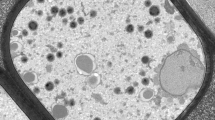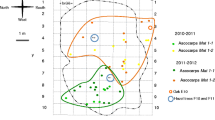Abstract
Sixty-seven isolates of Bipolaris sorokiniana of barley, belonging to three groups (black, white and mixed) were studied to find an association of melanin with the spore production of the fungus. Conidiogenesis in black, white and mixed subpopulation of B. sorokiniana was positively correlated with melanin content/g of mycelium. Primary hyphae of black and mixed subpopulation differentiated into secondary hyphal structures which subsequently produced conidiophores and conidia. Primary hyphae could not differentiate into secondary hyphae and subsequently conidiophores and conidia in white subpopulation. A melanin containing mutant developed from white subpopulation regained its ability to differentiate into secondary hyphae, conidiophores and conidia. Results showed that melanization of mycelia B. sorokiniana mycelia is an important factor for conidia production.



Similar content being viewed by others
References
Bell AA, Wheeler MH (1986) Biosynthesis and functions of fungal melanins. Annu Rev Phytopathol 24:411–451
Butler MJ, Day AW (1998) Destruction of fungal melanins by ligninases of Phanerochaete chrysosporium and other white rot fungi. Int J Plant Sci 159:989–995
Butler MJ, Day AW, Henson JM, Money NP (2001) Pathogenic properties of fungal melanins. Mycologia 93:1–8
Carzaniga R, Fiocco D, Bowyer P, O’Connell RJ (2002) Localization of melanin in conidia of Alternaria alternata using phage display antibodies. Mol Plant–Microbe Interact 15(3):216–224
Chand R, Singh HV, Joshi AK, Duveiller E (2002) Physiological and morphological aspects of Bipolaris sorokiniana on wheat straw. Plant Pathol J 18(6):328–332
Chand R, Pandey SP, Singh HV, Kumar S, Joshi AK (2003) Variability and its probable cause in the natural populations of spot blotch pathogen Bipolaris sorokiniana of wheat (T. aestivum L.) in India. J Plant Dis Protection 110:27–35
Chand R, Sen D, Prasad KD, Singh AK, Bashyal BM, Prasad LD, Joshi AK (2008) Screening for disease resistance in barley cultivars against Bipolaris sorokiniana using callus culture method. Indian J Exp Biology 36:249–253
Eliahu N, Igbaria A, Rose MS, Horwitz BA, Lev S (2007) Melanin biosynthesis in the maize pathogen Cochliobolus heterostrophus depends on two mitogen-activated protein kinases, Chk1 and Mps1, and the transcription factor Cmr1. Eukaryot Cell 6(3):421–442
Elliott ML (1995) Effect of melanin biosynthesis inhibiting compounds on Gaeumannomyces species. Mycologia 87:370–374
Eyal Z, Scharen AL, Prescott JM, van Ginkel M (1987) The septoria disease of wheat: concepts and methods of disease management. CIMMYT, Mexico, DF
Frederick BA, Caesar-TonThat TC, Wheeler M, Sheehan KB, Edens WA, Henson JM (1999) Isolation and characterization of Gaeumannomyces graminis melanin mutants. Mycol Res 103:99–110
Gadd GM (1982) Effects of media composition and light on colony differentiation and melanin synthesis in Microdochium bolleyi. Trans Br Mycolo Soc 78:115–122
Henson JM, Butler MJ, Day AW (1999) The dark side of the mycelium: melanins of phytopathogenic fungi. Ann Rev Phytopathol 37:447–471
Jaiswal SK, Sweta S, Prasad LC, Sharma S, Kumar S, Prasad R, Pandey SP, Chand R, Joshi AK (2007) Identification of molecular marker and aggressiveness for different groups of Bipolaris sorokiniana isolates causing spot blotch disease in wheat (Triticum aestivum L.). Curr Microbiol 55:135–141
Kawamura C, Moriwaki J, Kimura N, Fujita Y, Fuji S, Hirano T, Koizumi S, Tsuge T (1997) The melanin biosynthesis genes of Alternaria alternata can restore pathogenicity of the melanin deficient mutant of Magnaporthe grisea. Mol Plant–Microbe Interact 10:445–453
Kawamura C, Tsujimoto T, Tsuge T (1999) Targeted disruption of a melanin biosynthesis gene affects conidial development and UV tolerance in the Japanese pear pathotype of Alternaria alternata. Mol Plant–Microbe Interact 12:59–63
Kendrick B, Chang MG (1971) Karyology of conidiogenesis in some hyphomycetes. In: Kendrick B (ed) Taxonomy of fungi imperfecti. University of Toronto Press, Toronto, pp 278–291
Kumar D, Chand R, Prasad LC, Joshi AK (2007) A new technique for monoconidial culture of the most aggressive isolate in a given population of Bipolaris sorokiniana, cause of foliar spot blotch in wheat and barley. World J Microbial Biotechnol 23:1647–1651
Leach J, Lang BR, Yoder DC (1982) Methods for selection of mutants and in vivo culture of Cochliobolus heterostrophus. J Microbiol 128:1719–1729
Mishra AP (1981) Variability, physiologic specialization and genetics of pathogenicity in graminicolus Helminthosporium affecting cereal crops. Ind Phytopathol 34:1–22
Nelson RR (1960) Evolution of sexuality and pathogenicity I. Interspecific crosses in the genus Helminthosporium. Phytopathol 50:375–377
Pandey SP, Sharma S, Chand R, Shahi P, Joshi AK (2008) Clonal variability and its relevance in generation of new pathotypes in the spot blotch pathogen, B. sorokiniana. Curr Microbiol 56:33–41
Rizner TL, Wheeler MH (2003) Melanin biosynthesis in the fungus Curvularia lunata (teleomorph: Cochliobolus lunatus). Can J Microbiol 49:110–119
Roelfs AP, Singh RP, Saari EE (1992) Rust diseases of wheat: concepts and methods of disease management. CIMMYT, Mexico D.F, pp 37–38
Romero-Martinez R, Wheeler M, Guerrero-Plata A, Rico G, Torres-Guerrero H (2000) Biosynthesis and function of melanin in Sporothrix schenckii. Infect Immunol 68:3696–3703
Saari EE, Prescott JM (1975) A scale for appraising the foliar intensity of wheat disease. Plant Dis Rep 59:377–380
Saghai Maroof MA, Soliman KM, Jorgensen RA, Allarde RW (1984) Ribosomal RNA-spacer-length polymorphism in barley: Mendalian inheritance chromosomal location and population dynamics. Proc Natl Acad Sci USA 81:8014–8018
Shimizu K, Tanaka C, Tsuda M (1997) Cloning of Brn 1, a reductase gene involved in melanin biosynthesis in Cochliobolus heterostrophus. J Gen Appl Microbiol 43:145–150
Sussman AS (1968) Longevity and survivability of fungi. In: Ainsworth GC, Sussman AS (eds) The fungi, vol III. Academic Press, New York, pp 447–486
Tanabe K, Park P, Tsuge T, Kohmoto K, Nishimura S (1995) Characterization of the mutants of Alternaria alternata Japanese pear pathotype deficient in melanin production and their pathogenicity. Ann Phytopathol Soc Jpn 61:27–33
Tinline RD (1961) Cochliobolus sativus V. Heterokayosis and parasexualtiy. Can J Bot 40:425–437
Zadock JC, Chang TT, Konzak CF (1974) A decimal code for the growth stages of cereals. Weed Res 14:415–421
Acknowledgments
Authors are thankful to University Grant Commission for the financial assistance.
Author information
Authors and Affiliations
Corresponding author
Rights and permissions
About this article
Cite this article
Bashyal, B.M., Chand, R., Kushwaha, C. et al. Association of melanin content with conidiogenesis in Bipolaris Sorokiniana of barley (Hordeum vulgare L.). World J Microbiol Biotechnol 26, 309–316 (2010). https://doi.org/10.1007/s11274-009-0177-1
Received:
Accepted:
Published:
Issue Date:
DOI: https://doi.org/10.1007/s11274-009-0177-1




